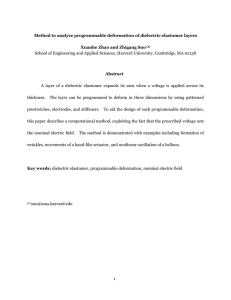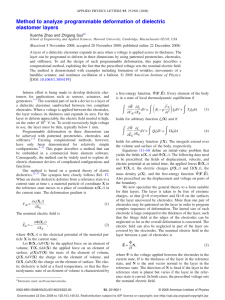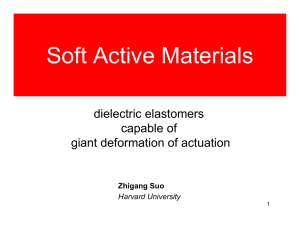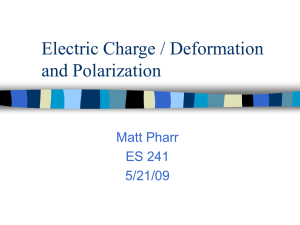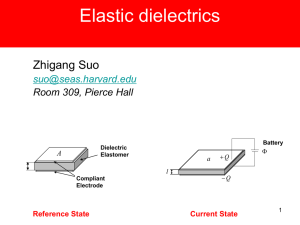Propagation of instability in dielectric elastomers Jinxiong Zhou , Wei Hong
advertisement
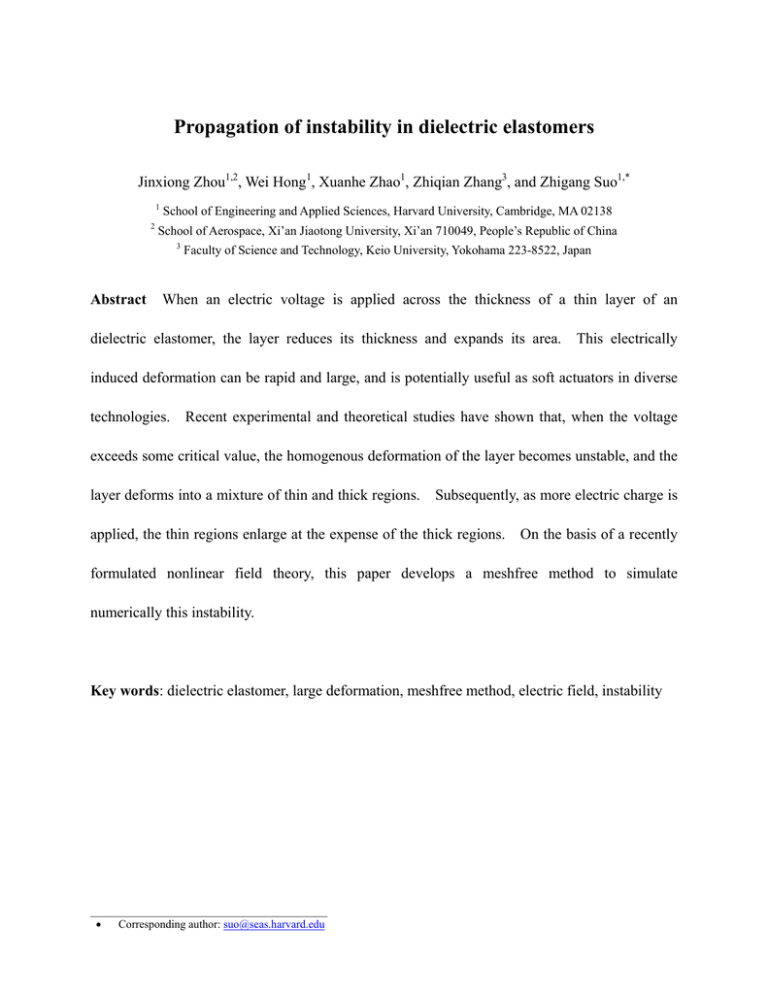
Propagation of instability in dielectric elastomers Jinxiong Zhou1,2, Wei Hong1, Xuanhe Zhao1, Zhiqian Zhang3, and Zhigang Suo1,* 1 2 School of Engineering and Applied Sciences, Harvard University, Cambridge, MA 02138 School of Aerospace, Xi’an Jiaotong University, Xi’an 710049, People’s Republic of China 3 Abstract Faculty of Science and Technology, Keio University, Yokohama 223-8522, Japan When an electric voltage is applied across the thickness of a thin layer of an dielectric elastomer, the layer reduces its thickness and expands its area. This electrically induced deformation can be rapid and large, and is potentially useful as soft actuators in diverse technologies. Recent experimental and theoretical studies have shown that, when the voltage exceeds some critical value, the homogenous deformation of the layer becomes unstable, and the layer deforms into a mixture of thin and thick regions. Subsequently, as more electric charge is applied, the thin regions enlarge at the expense of the thick regions. On the basis of a recently formulated nonlinear field theory, this paper develops a meshfree method to simulate numerically this instability. Key words: dielectric elastomer, large deformation, meshfree method, electric field, instability __________________________________________ • Corresponding author: suo@seas.harvard.edu 1. Introduction Dielectric elastomers are being used to develop lightweight, low-cost, and compliant actuators. Potential applications include artificial muscles for robots, micro air vehicles, and medical devices (e.g., Sugiyama and Hirai, 2006; Kofod et al., 2007; Chu et al., 2006; Pelrine et al., 2002; Zhang et al., 2002; Galler et al., 2006; Tolksdorf et al., 2001). Partly stimulated by these technological potentials, there has been renewed interest in developing nonlinear field theory of elastic dielectrics (e.g., Dorfmann and Ogden, 2005; McMeeking and Landis, 2005; Suo, Zhao and Greene, 2007; Vu et al., 2007). For example, Suo, Zhao and Greene (2007) have abandoned the troublesome notions of electric body force and Maxwell stress, and formulated a theory consisting of decoupled, linear partial differential equations and boundary conditions, with nonlinear electromechanical coupling fully captured by a free-energy function. On the basis of this theory, the present paper develops a meshfree method to simulate a phenomenon observed in electrically induced deformation. It was Stark and Garton (1955) who first reported that the breakdown fields of polymers reduced when the polymers became soft at elevated temperatures. The phenomenon is understood as follows. The electric voltage is applied between the electrodes on the top and the bottom surfaces of a thin layer of a polymer. As the electric field increases, the polymer thins down, so that the same voltage will induce an even higher electric field. This positive feedback results in a mode of instability, known as electromechanical instability or pull-in instability, which causes the polymer to reduce the thickness drastically, often leading to electrical breakdown. 2 This instability has been 5/22/2007 recognized as a failure mode of the insulators for power transmission cables (Dissado and Fothergill, 1992). A different experimental manifestation of the electromechanical instability has been reported recently (Plante and Dubowsky, 2006). Under certain conditions, an electric voltage can deform a layer of a dielectric elastomer into a mixture of two regions, one being flat and the other wrinkled (Fig. 1). In the experiment, the electrodes on the top and the bottom surfaces of the dielectric layer were made of conducting grease, which applied a uniform electric potential to the elastomer without constraining its deformation. This experimental observation has been interpreted as follows (Zhao, Hong and Suo, 2007). Figure 2a sketches the experimental observation with a top view and cross sectional view. Figure 2b sketches the relation between the electric voltage Φ applied between the top and the bottom electrodes and the magnitude of the electric charge Q on either electrode. When the voltage is small, the elastomer deforms slightly, and the charge increases with the voltage approximately linearly. As the voltage increases, the elastomer thins down significantly, and a small increase in the voltage adds a large amount of charge on either electrode. Consequently, the voltage may reach a peak; as more charge is added on the electrodes, the elastomer thins down further, and the voltage needed to maintain the charge drops. The peak voltage corresponds to the pull-in instability. When the elastomer is thin enough, however, the large deformation may stiffen the elastomer significantly so that the voltage must increase again to thin down the elastomer further. At a given voltage, the thin state requires more charge. Consequently, as more charge is applied, the thin region enlarges at the expense of the thick 3 5/22/2007 region. The mixture of the two regions is in equilibrium when the electric voltage is held at a level that makes the two shaded areas in Fig.2b equal. The thin region expands laterally more than the thick region, and wrinkles to partially relieve the elastic energy. The analysis of Zhao, Hong and Suo (2007) assumes that the thin region and the thick region are each in a state of homogenous deformation, and neglects the constraint between the two regions. Starting with this paper, we wish to develop methods to analyze the inhomogeneous deformation. This paper is organized as follows. Section 2 summarizes the nonlinear field theory of elastic dielectrics. Section 3 describes a procedure to discretize the field equations using a meshfree method, and solve the resulting nonlinear algebraic equations using the Newton-Ralphson method. ideal dielectric elastomer. Section 4 describes a material model, which we call the As a first attempt to analyze the transition between the thin and the thick states, Section 5 introduces a two-dimensional model. Section 6 reports preliminary numerical results. 2. Nonlinear field theory of elastic dielectrics This section summarizes the nonlinear field theory of elastic dielectrics, following closely the formulation of Suo, Zhao and Greene (2007). Only the relations relevant to the present work are included; the reader is directed to the original paper for motivations for various definitions. We model an elastic dielectric as a continuous body of material particles. The body may extend to the entire space, but may contain interfaces between dissimilar media. Any state of the body can serve as a reference state. In the reference state, let X be the coordinates 4 5/22/2007 of a material particle, dV (X ) be an element of volume around X, and dA(X ) be an element of an interface around X. In the current state at time t, the material particle X is at a place with coordinates xi = xi (X, t ) . The deformation gradient tensor is FiJ (X, t ) = ∂xi (X, t ) . ∂X J (1) Imagine that each material particle is connected to a weight that applies a force, and the body is subject to a field of weights. In the current state, the field of weights applies force ~ ~ bi (X, t )dV (X ) on the material element of volume, and applies force ti (X, t )dA(X ) on the material element of an interface. Let ξi (X ) be a vector test function. Define the tensor of nominal stress siJ (X, t ) such that ∫s iJ ~ ∂ξ i dV = ∫ biξ i dV + ∫ ~ tiξ i dA ∂X J (2) holds true for arbitrary test function ξi (X ) . The volume integrals extend to the volume of the body in the reference state, and the surface integral extends to the interfaces in the reference state. In the above definition, the test function ξi (X ) needs to have no physical interpretation and can be of any unit. In a special case, when the test function is a small, actual deformation of the body, δxi (X, t ) , the right-hand side of (2) is the actual incremental work done by the field of weights. Consequently, the nominal stress is work-conjugate to the deformation gradient. To define various electrical quantities, imagine that each material particle is connected to a battery, which maintains the electric potential of the material particle, Φ (X, t ) , with respect to the ground. The material itself is an insulator, but the battery may pump electric charge from 5 5/22/2007 the ground to the material particle. In the current state at time t, define the nominal electric field by the gradient of the electric potential: ∂Φ(X, t ) ~ EJ (X, t ) = − ∂X J (3) Let q~ (X, t )dV (X ) be the electric charge on the element of volume, and ω~ (X, t )dA(X ) be the electric charge on the element of an interface. Let η (X ) be a scalar test function. Define the ~ vector of nominal electric displacement, DJ (X, t ) , such that the equation ~ ∂η − ∫ DJ dV = ∫ q~ηdV + ∫ ω~ηdA ∂X J (4) ~ holds true an arbitrary test function η. This definition is equally valid when we replace DI , q~ ~ and ω~ by corresponding increments, δDJ , δq~ and δω~ . The test function η (X ) needs to have no physical interpretation and can be of any unit. In a special case, when η is the actual ~ electric potential Φ (X, t ) , and when the increments δDJ , δq~ and δω~ are used, the right-hand side of (4) is the actual incremental work done by the field of batteries. Consequently, the nominal electric displacement is work-conjugate to the nominal electric field. For an elastic dielectric, the work done by the field of weights, done by the field of batteries, ∫s iJ δFiJ dV , and the work ~ ~ ∫ E δD dV , are stored fully in the body as the Helmholz free J J energy. We next localize this statement by introducing an assumption. Let WdV (X ) be the Helmholz free energy of a material element of volume. We assume that, associated with the ~ actual changes, δFiJ and δDJ , the free energy of the material element changes by ~ ~ δW = siJ δFiJ + EJ δDJ . (5) Define the electrical Gibbs free energy by 6 5/22/2007 ~ ~ Wˆ = W − EJ DJ . (6) A combination of (5) and (6) gives that ~ ~ δWˆ = siJ δFiJ − DJ δEJ . (7) ( ) ~ Thus, an elastic dielectric is characterized by the Gibbs free energy function Ŵ F, E . Once this function is specified, the material laws are ~ ∂Wˆ (F, E) ~ siJ (F, E) = , ∂FiJ (8a) ~ ∂Wˆ (F, E) ~ ~ DJ (F, E) = − . ~ ∂EJ (8b) ~ According to definition (3), the nominal electric field E is invariant when the entire system in the current state rotates as a rigid body. According definition (1), however, the deformation gradient F varies when the system in the current state rotates as a rigid body. To ensure that Wˆ is invariant under such a rigid-body rotation, following a usual practice, we invoke the right Cauchy-Green deformation tensor, C IJ = FkI FkJ , and write the free energy as a function ( ) ~ Wˆ = Wˆ C, E . (9) Consequently, the material laws (8) become ~ ∂Wˆ (C, E) ~ , siJ (C, E) = 2 FiL ∂C JL (10a) ~ ∂Wˆ (C, E) ~ ~ . DJ (C, E) = − ~ ∂EJ (10b) As shown in Suo, Zhao and Greene (2007), definitions (1)-(4) result in a set of linear partial deferential equations and linear boundary conditions, with the mechanical fields 7 5/22/2007 decoupled from the electrical fields. Nonlinearity and electromechanical coupling enters solely ( ) ~ through the free-energy function Wˆ = Wˆ C, E . In numerical calculations, as well as in device applications, one often invokes small ~ changes near a given state. Let the given state be characterized by C and E . Associated ~ with small changes in the deformation gradient and in the nominal electric field, δFiJ and δEJ , the changes in the nominal stress and the nominal electric displacements are ~ δsiJ = H iJkLδFkL − eiJLδEL , ~ (11a) ~ δDJ = eiJLδFiL + ε JLδEL . (11b) The various tangent moduli depend on the given state, and can be calculated from the Gibbs free energy: ( ) ( ) ~ ~ ∂Wˆ C, E ∂Wˆ C, E ~ , H iJkL C, E = 2δ ik + 4 FiM FkN ∂C JL ∂C JM ∂C LN ( ) eiJL ( ) ~ ∂Wˆ C, E ~ C, E = −2 FiM ~ , ∂C JM ∂EL ( ) ε JL ( ) ~ ∂Wˆ C, E ~ C, E = − ~ ~ . ∂EJ ∂EL ( ) (12a) (12b) (12c) 3. Discretization and numerical solver In the current state at time t, interpolate the position vector xi (X, t ) and the electric potential Φ (X, t ) as xi ( X, t ) − X i = N a ( X)uai (t ) , (13a) Φ( X, t ) = N a ( X)Φ a (t ) . (13b) 8 5/22/2007 The index a, as well as the index b below, is reserved for nodes; repeated a (or b) implies summation over all nodes in the body. The quantities uai (t ) and Φ a (t ) are the discretized displacement and electric potential associated with node a. The shape functions N a (X ) can be constructed in several ways; we adopt a meshfree procedure; detailed implementation can be found in Belytschko et al. (1994), Liu et al. (1995) and Chen et al. (1996). The test functions are similarly discretized: ξi (X ) = N a (X )ξ ai , (14a) η (X ) = N a (X )η a , (14b) where ξ ai and ηa are the discretized test functions associated with node a. The discretized deformation gradient and the discretized electric potential are FiJ (X, t ) = δ iJ + ∂N a uai (t ) , ∂X J ∂N ~ E J (X, t ) = − a Φ a (t ) . ∂X J (15a) (15b) Substituting (13) and (14) into (2) and (4), and invoking the arbitrariness of the test functions, we obtain that ∫s iJ ~ ∂N a dV = ∫ bi N a dV + ∫ ~ ti N a dV . ∂X J ~ ∂N a − ∫ DJ dV = ∫ q~N a dV + ∫ ω~N a dV . ∂X J (16a) (16b) ( ) ~ For a given elastic dielectric, the free-energy function Ŵ C, E is prescribed. The material laws (10), in conjunction with the discretization (15), express the nominal stress siJ and the 9 5/22/2007 ~ nominal electric displacement DJ in terms of uai (t ) and Φ a (t ) . Consequently, (16) is a set of nonlinear algebraic equations for uai (t ) and Φ a (t ) . At a given time t, we solve the nonlinear algebraic equations (16) using the Newton-Raphson method. Let uai and Φ a be the values at a particular iteration. Through ~ material laws (10), one can calculate the associated values of siJ and DJ . The increments for the iteration, δuai and δΦ a , are determined by a set of linear algebraic equations: ⎡ ⎤ ⎡ ⎤ ~ ∂N a ∂N a ∂N b ∂N a ∂N b ~ dV , (17a) dV ⎥δΦ b = ∫ bi N a dV + ∫ ti N a dV − ∫ siJ dV ⎥δubk − ⎢ ∫ eiJL ⎢ ∫ H iJkL ∂X J ∂X J ∂X L ∂X J ∂X L ⎣ ⎦ ⎣ ⎦ ⎡ ⎤ ⎡ ⎤ ∂N a ∂N b ∂N a ∂N b ~ ∂N a − ⎢ ∫ ekJL dV . (17b) dV ⎥δΦ b = ∫ q~N a dV + ∫ ω~N a dV + ∫ DJ dV ⎥δubk − ⎢ ∫ ε JL ∂X J ∂X J ∂X L ∂X J ∂X L ⎣ ⎦ ⎣ ⎦ Given a close enough initial guess, the Newton-Raphson method has a relatively fast convergence rate. To automate the process of making good guesses, the usual approach is to combine the iteration with an incremental scheme. One divides the external load into a number of increments, uses the reference state as the initial guess for the first increment, iterates within each increment until convergence, and uses the converged result as an initial guess for the next increment. 4. Ideal dielectric elastomers For a given elastic dielectric, the material laws are fully specified by the free-energy ( ) ~ function Ŵ C, E . Writing an explicit form of this function for any real material is a challenging task. For many dielectric elastomers, experiments seem to suggest that (a) the true electric displacement is approximately linear in the true electric field, D = εE , and (b) the 10 5/22/2007 permittivity ε is approximately independent of the state of deformation (Pelrine, Kornbluh and Joseph, 1998; Pelrine et al., 2000; Kofod and Sommer-Larsen, 2005; Plante and Dubowsky, 2006). These observations may be interpreted using a molecular picture. When molecular groups in an elastomer can polarize nearly as freely as in liquids, e.g., when the degree of crosslink is low and the deformation is well before individual molecular chains are fully extended, the dielectric behavior of the elastomer is expected to be liquid-like. The linearity simply suggests that the applied electric field is still too low to perfectly align polar groups (if there are any) to saturate polarization. Let W0 (C) be the free-energy function of the elastomer in the absence of the electric field. For the ideal dielectric elastomer, the dielectric energy per unit volume is εE 2 / 2 . Recall ~ that the true electric field relates to the nominal electric field as EJ = FiJ Ei , so that ~ ~ −1 E 2 = CIJ−1EI E J , where C IJ are the components of the tensor C−1 . Following Zhao, Hong and Suo (2007), we define an ideal dielectric elastomer by writing the free energy as the sum of the elastic energy and the dielectric energy: ( ) 1 ~ ~ ~ Wˆ C, E = W0 (C) − εCIJ−1EI EJ . 2 (18) While it will be interesting to investigate how well the ideal dielectric elastomer represents a real one, in this paper we will use the ideal dielectric elastomer to develop the theory. The elastomer is taken to be incompressible. We adopt a series expression developed by Arruda and Boyce (1993): ( ) ( ) 1 11 ⎡1 ⎤ W0 = µ ⎢ (I − 3) + I2 −9 + I 3 − 27 + ...⎥ , 2 20 N 1050 N ⎣2 ⎦ 11 (19) 5/22/2007 where µ is the small-strain shear modulus, I = CKK , and N is the number of rigid molecular segments in a polymer chain between crosslinks. Inserting (18) into (10), we obtain the material laws: siJ = 2 dW0 ~ ~ −1 , FiJ − pFJi−1 + εEL EK FLi−1CKJ dI ~ ~ −1 DJ = εELC JL , (20a) (20b) where p is a penalty coefficient introduced to enforce incompressibility (e.g., Holzapfel, 2001, p. 222). 5. A two-dimensional approximation The above formulation is valid for three-dimensional fields. While the instability reported by Plante and Dubowsky (2006) involves three-dimensional deformation, in this first numerical treatment of this instability, we will formulate an approximate two-dimensional model. Let X 3 be the direction along the wave vector of the wrinkles. In this direction, we expect that the nominal stress s33 is nearly relieved by the wrinkles. In the approximate model, we set s33 = 0 . We will study the field in a Greek subscripts run from 1 to 2. ( X1, X 2 ) ~ plane, and neglect Fα 3 , F3Γ and E3 ; the We do allow the stretch along the x3 direction, F33 = λ3. The incompressibility of the elastomer relates λ3 to the in-plane deformation as λ3 = 1 C11C22 − C122 . (21) The above two-dimensional approximation is rigorous when the material undergoes a homogenous deformation and is stress-free in the X 3 direction. For situations with coexistent 12 5/22/2007 states of different thicknesses, error occurs in the transition regions between two phases; a more rigorous model will be formulated in a subsequent paper. Substituting s33 = 0 into (20a), we find that p = 2λ32 dW0 . dI (22) We can rewrite the in-plane components of the nominal stress tensor as sαΓ = 2 ( ) dW0 ~ ~ −1 . FαΓ − λ32 FΓ−α1 + εEΛ EΘ FΛ−α1 CΘΓ dI (23) The tangent moduli can be calculated from ( ) ~ ⎡ d 2W λ2 dW0 ∂Wˆ C, E −1 −1 −1 −1 −1 −1 −1 −1 ⎤ δ ΘΞ − λ32CΘΞ 2CΓΛ = 4⎢ 2 0 δ ΓΛ − λ32CΓΛ + 3 4 CΘΞ + CΓΘ CΛΞ + CΓΞ CΛΘ ⎥ 2 dI ∂CΓΛ ∂CΘΞ ⎣ dI ⎦ , (24) ~ ~ −1 −1 −1 −1 −1 −1 −1 −1 −1 −1 − εEΠ EΣ CΛΠ CΓΘCΞΣ + CΓΞCΘΣ + CΓΣ CΛΞCΘΠ + CΛΘCΞΠ ( )( [ ( ) ) 2 ( ) )] ( ~ ∂Wˆ (C, E) ~ −1 −1 −1 −1 ~ = εEΞ CΓΘCΛΞ + CΓΞ CΛΘ . ∂CΓΛ ∂EΘ ( ) (25) 6. Numerical results and discussion As a numerical example, consider a thin layer of a dielectric elastomer sandwiched between two compliant electrodes. A voltage Φ is applied between the two electrodes, and no external forces are applied. homogenous. When the voltage is small, the deformation in the layer is When the voltage reaches a critical value, however, the homogenous deformation is unstable, and gives way to inhomogeneous deformation. Zhao, Hong and Suo (2007) have analyzed the stability of the homogenous deformation. Here we will use our numerical procedure to recover the homogenous deformation, and analyze the inhomogeneous deformation. 13 5/22/2007 We first summarize the basic results of the homogenous deformation. Let H the thickness of the undeformed elastomer, and λH be the thickness of the deformed elastomer. ~ In the current state, the nominal electric field is E = Φ / H , and the true electric field is ~ E = Φ / (λH ) = E / λ . Due to incompressibility, the stretch in a direction normal to the thickness is λ−1 / 2 . Consequently, I = λ2 + 2λ−1 , and the free-energy function of the elastomer is ~ 2 ⎛ ⎞ E ε ~ Wˆ λ , E = W0 (λ ) − ⎜⎜ ⎟⎟ , 2⎝ λ ⎠ ( ) where W0 (λ ) is obtained by inserting I = λ2 + 2λ−1 into (19). (26) The nominal stress in the thickness direction is ( ) ~ ∂Wˆ λ , E dW0 (λ ) ~ 2 − 3 s= = + εE λ . ∂λ dλ (27) The nominal electric displacement is ( ) ~ ∂Wˆ λ , E ~ ~ D=− = εEλ− 2 . ~ ∂E (28) Because no external force is applied, s = 0 , and (27) and (28) may be written as λ3dW0 (λ ) ~ , E= − εdλ εdW0 (λ ) ~ . D= − λ dλ (29) ~ ~ This pair of equations define the relation between D and E , with λ as a parameter. We next use our meshfree code to recover this homogeneous deformation. For the homogenous deformation, the size of the block is unimportant, and is set to be L×H with the aspect ratio L H = 1 (Fig. 3), discretized using 132 nodes. Figure 4 compares the calculated ( ) voltage-charge relation with (29). The voltage is normalized as Φ / H ε / µ , and the charge 14 5/22/2007 ( ) is normalized as Q / L εµ . The only dimensionless parameter in the problem is N in (19). The numerical results agree well with the analytical solutions, even when a homogenous deformation is unstable, i.e. the parts in the plot with negative slopes. The exception is when N → ∞ , where the instability is so catastrophic that even a smallest numerical error makes the Newton-Raphson iteration diverge. We finally use the meshfree code to simulate inhomogeneous deformation. The size of the block is now set as L×H, with the aspect ratio L H = 8 (Fig. 5). The block is discretized using 246 nodes. The material parameter is taken to be N = 2.8. To introduce an initial imperfection, we modify the vertical coordinates of there nodes on the top surface, lowering the middle node by 0.002H, and lowering the two neighboring nodes by 0.001H. We use the total charge Q on the top electrode to control the incremental loading and unloading process. Four stages of deformation can be observed, noted as B, C, D and E in Figs. 6 and 7. (The stage A in figure 7 denotes the reference state.) In stage B, the elastomer is uniformly thinned, all the way until it reaches some point near the critical voltage, when the homogenous deformation is unstable and a local region thins down preferentially. In stages C and D, the elastomer deforms into a mixture of two states. The voltage keeps constant, but as electric charge is pumped onto the electrodes, the thin region grows at the expense of the thick region. From stage C to stage D, instability propagates in the elastomer. In these stage, the numerical solution deviates from the analytical homogenous solution, shown as a horizontal line in Fig. 6. The deformation becomes homogenous when the thick region is exhausted. In stage E, the material deforms uniformly again, but with a much thinner thickness. 15 When we unload the 5/22/2007 material by withdrawing electric charge from the electrodes, the material relaxes almost along the same route, except for the position of critical points. 7. Concluding remarks On the basis of a recently formulated nonlinear field theory of elastic dielectrics, we have developed a meshfree code to simulate electrically induced finite deformation in elastomers. The procedure is demonstrated for the ideal dielectric elastomer, subject to two-dimensional approximations, using meshfree method. We apply the numerical method to simulate a layer subject to a voltage. When the voltage is small, the deformation of the layer is homogenous. When the voltage reaches a certain value, deformation becomes inhomogeneous, with coexistent thin and thick state. At a constant voltage, as the battery pumps more charge to the two electrodes, the thin region expands at the expense of the thick region. The general numerical procedure has the clear potential to be extended to simulate more complex modes of deformation in dielectric elastomers. Acknowledgement This research was supported by the Army Research Office through contract W911NF-04-1-0170, and the National Science Foundation through the MRSEC at Harvard University. JZ also acknowledges the support of Natural Science Foundation of China (through grant Nos. 10572112 and 10202018), Natural Science Foundation of Shaanxi province (through grant No. 2006A01) and National Basic Research Program of China under grant number 2006CB601202. 16 5/22/2007 References Allik, H., Hughes, T. J. R., 1970. Finite element method for piezoelectric vibration, Int. J. Numer. Methods. Engrg., 2, 151-157. Arruda, E. M. and Boyce, M. C., 1993. A three-dimensional constitutive model for the large stretch behavior of rubber elastic materials, J. Mech. Phys. Solids, 41, 389-412. Belytschko, T., Lu, Y. Y., Gu, L., 1994. Element-Free Galerkin Methods, Int. J. Numer. Methods Engrg., 37, 229-256. Carpi, F. and Rossi, D. D., 2004. Dielectric elastomer cylindrical actuator: electromechanical modeling and experimental evaluation, Mater. Sci. Engrg. C, 24, 555-562. Chen, J. S., Pan, C., Wu, C. T., Liu, W. K., 1996. Reproducing kernel particle methods for large deformation analysis of nonlinear structures, Comput. Methods Appl. Mech. Engrg., 139, 195-229. Chu, B. J., Zhou, X., Ren, K. L., Neese, B., Lin, M. R., Wang, Q., Bauer, F., Zhang, Q. M., 2006. A dielectric polymer with high electric energy density and fast discharge speed. Science 5785, 334-336. Dissado, L.A. and Fothergill, J.C. in Electrical Degradation and Breakdown in Polymers (Peter Peregrinus Ltd., London, 1992). Dorfmann, A., Ogden, R. W., 2005. Nonlinear electroelasticity. Acta Mechanica, 174, 167-183. Galler, N., Ditlbacher, H., Steinberger, B., 2006. Electrically actuated elastomers for electo-optical modulators, Appl. Phys. B, 85, 7-10. 17 5/22/2007 Gaudenzi, P., Bathe, K. J., 1995. An iterative finite element procedure for the analysis of piezoelectric continua. J. Intell. Mater. Syst. Structures, 6, 266-273. Holzapfel, G.A., 2001. Nonlinear Solid Mechanics. Wiley, New York. Hwang, W. S., Park, H. C., 1993. Finite element modeling of piezoelectric sensors and actuators, AIAA Journal, 31, 930-937. Kofod, G. and Sommer-Larsen P., 2005, Silicon dielectric elastomer actuators: finite elasticity model of actuation. Sensors and Actuators A 122, 273-283 Kofod, G., Wirges, W., Paajanen, M., Bauer, S., 2007. Energy minimization for self-organized structure formation and actuation, Applied Physics Letters, 90, 081916 Liu, W. K., Jun, S., Zhang, Y. F., 1995. Reproducing Kernel Particle Methods, Int. J. Numer. Methods Engrg., 20, 1081-1106. McMeeking, R.M., Landis, C.M., 2005, Electrostatic Forces and Stored Energy for Deformable Dielectric Materials, Journal of Applied Mechanics, 72, 581-590 Plante, J. S., Dubowsky, S., 2006. Large-scale failure modes of dielectric elastomer actuators, Int. J. Solids Struct., 43, 7727-7751. Pelrine, R., Kornbluh, R. and Joseph, J., 1998, Electrostriction of polymer dielectrics with compliant electrodes as a means of actuation, Sensors and Actuators A: Physical 64, 77-85. Pelrine, R., Kornbluh, R., Pei, Q., Joseph, J., 2000. High-speed electrically actuated elastomers with strain greater than 100%, Science, 287, 836-839. Stark, K.H., Garton, C.G., 1955, Electric Strength of Irradiated Polythene, Nature, 176, 1225-1226. 18 5/22/2007 Sugiyama, Y., Hirai, S., 2006. Crawling and Jumping by a Deformable Robot, The International Journal of Robotics Research, 25, 603-620 Suo Z., Zhao X., Greene W. H., 2007. A nonlinear field theory of deformable dielectrics. J. Mech. Phys. Solids (in press). Preprint and comments are available online http://imechanica.org/node/635. Tolksdorf, C., Gebhard, E., Zentel, R., Kruger, P., Losche, M., Kremer, F., 2001. Giant lateral electrostriction in ferroelectric liquid-crystalline elastomers, Nature, 410, 447-450. Vu D. K., Steinmann P., Possart G., 2007. Numerical modelling of non-linear electroelasticity, Int. J. Numer. Meth. Engng., 70, 685-704. Wang D. W., Tzou, H. S., Lee, H. J., 2004. Control of nonlinear electro/elastic beam and plate systems (finite element formulation and analysis), Jurnal of Vibration and Acoustics ASME, 126, 63-70. Xu, C. G., Fiez, T. S., Mayaram K., 2003. Nonlinear finite element analysis of a thin piezoelectric laminate for micro power generation, J. Microelectromechanical systems, 12, 649-655. Zhang, Q. M., Li, H., Poh, M., Xia, F., Cheng, Z. Y., Xu, H., Huang, C., 2002. An all-organic composite actuator material with a high dielectric constant, Nature, 419, 284-287. Zhao, X., Hong, W., Suo, Z., 2007, Electromechanical hysteresis and coexistent states in dielectric elastomers, submitted for publication, http://imechanica.org/node/1283 . 19 5/22/2007 ~3mm Figure 1. An experimental observation of electromechanical instability (courtesy of JS Plante and S Dubowsky). A layer of a dielectric elastomer, coated with conductive grease on top and bottom faces, is pre-stretched using a frame. An electric voltage is applied between the two electrodes. The layer deforms into a mixture of two regions, one being flat and the other wrinkled. For further experimental details see Plante and Dubowsky (2006). 20 5/22/2007 Top view Φ Section (a) Φ Φ* Q (b) Figure 2. (a) A schematic of an experimental observation reported by Plante and Dubowsky (2006). A thin layer of a dielectric elastomer is subject to an electric voltage across its thickness. When the voltage is small, the layer deforms homogeneously, thinning in the thickness direction and expanding in the lateral directions. When the voltage reaches a certain level, the homogeneous deformation becomes unstable, and the layer deforms into a mixture of two states, one being flat and the other wrinkled. (b) A schematic plot of the relation between the voltage applied between the two electrodes and the magnitude of the electric charge on either electrode. 21 5/22/2007 H -Q Φ H +Q Figure 3. A schematic of the computational model. A square block (H × H ) of dielectric elastomer, with two sides constrained frictionlessly, and two compliant electrodes deposited on the top and bottom sides. A voltage Φ is applied between the two electrodes, and induces charge +Q on one electrode, and –Q on the other electrode. 22 5/22/2007 1 0.9 0.8 0.6 Φ/(H p /µ) 0.7 0.5 0.4 Analytical N=2.8 Numerical N=2.8 Analytical N=5 Numerical N=5 0.3 0.2 Analytical N=∞ Numerical N=∞ 0.1 0 0 1 2 3 4 5 6 √ Q/(L µ) 7 8 9 10 Figure 4. A comparison between the numerical and analytical results of the dimensionless voltage versus the dimensionless charge. No initial imperfection is introduced. For Arruda-Boyce materials (N = 2.8 and 5), the numerical results agree well with the analytical solutions, even in the region when the homogenous solution is unstable. For neo-Hookean material (N = ∞), in the region when the homogenous solution is unstable, the Newton-Raphson iteration fails to converge. 23 5/22/2007 L -Q H Φ +Q Figure 5. A schematic of the computational model of a rectangular block (L × H ) of dielectric elastomer, with a small imperfection. (The size of the imperfection is exaggerated for visual clarity.) The left and bottom sides are constrained frictionlessly. Two compliant electrodes are deposited on the top and bottom surfaces. A voltage Φ is applied between the two electrodes, and induces charge +Q on one electrode, and –Q on the other electrode. 24 5/22/2007 0.845 0.84 E /µ) 0.835 D Φ(H p 0.83 0.825 0.82 C Analytical Numerical - loading Numerical - unloading 0.815 B 0.81 2 3 4 5 6 √ Q/(L µ) 7 8 9 10 Figure 6. Numerical and analytical results of the dimensionless voltage as a function of the dimensionless charge. An Arruda-Boyce material with N = 2.8 is assumed. Stage A denotes the reference state and is not shown here. State B and E represent two homogeneous states while C and D are the transition states between states B and E. States C and D corresponding to inhomogeneous deformations and can not be obtained by analytical method. 25 5/22/2007 A B C D E Figure 7. A sequence of deformation as obtained by numerical simulation. A is the reference state without deformation, stages B and E are in the conditions when a homogenous solution is stable, and the elastomer deforms uniformly. In stages C and D, two states of different thicknesses coexist. From stage C to stage D, instability propagates in elastomer. When the charge on the electrodes increases, the thinner region grows at the expense of the thicker region until the thicker region is exhausted. When the charge decreases, the thinner region shrinks until it reaches the uniform thicker state. 26 5/22/2007
